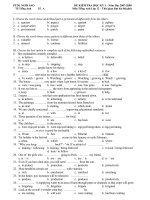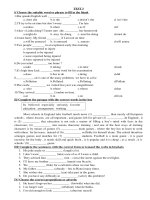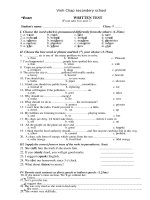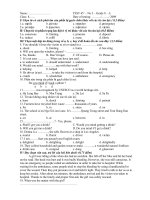Physics section test (3)
Bạn đang xem bản rút gọn của tài liệu. Xem và tải ngay bản đầy đủ của tài liệu tại đây (594.43 KB, 10 trang )
MCAT Section Tests
Dear Future Doctor,
The following Section Test and explanations should be used to practice and to assess
your mastery of critical thinking in each of the section areas. Topics are confluent and
are not necessarily in any specific order or fixed proportion. This is the level of
integration in your preparation that collects what you have learned in the Kaplan
classroom and synthesizes your knowledge with your critical thinking.
Simply
completing the tests is inadequate; a solid understanding of your performance through
your Score Reports and the explanations is necessary to diagnose your specific
weaknesses and address them before Test Day.
All rights are reserved pursuant to the copyright laws and the contract clause in your
enrollment agreement and as printed below. Misdemeanor and felony infractions can
severely limit your ability to be accepted to a medical program and a conviction can
result in the removal of a medical license. We offer this material for your practice in your
own home as a courtesy and privilege. Practice today so that you can perform on test
day; this material was designed to give you every advantage on the MCAT and we wish
you the best of luck in your preparation.
Sincerely,
Albert Chen
Executive Director, Pre-Health Research and Development
Kaplan Test Prep
© 2003 Kaplan, Inc.
All rights reserved. No part of this book may be reproduced in any form, by Photostat, microfilm,
xerography or any other means, or incorporated into any information retrieval system, electronic
or mechanical without the written permission of Kaplan, Inc. This book may not be duplicated,
distributed or resold, pursuant to the terms of your Kaplan Enrollment Agreement.
Physical Sciences
Test 2
Time: 35 Minutes
Number of Questions: 27
MCAT
PHYSICAL SCIENCES
DIRECTIONS: Most of the questions in the following
Physical Sciences test are organized into groups, with
a descriptive passage preceding each group of
questions. Study the passage, then select the single
best answer to each question in the group. Some of
the questions are not based on a descriptive passage;
you must also select the best answer to these
questions. If you are unsure of the best answer,
eliminate the choices that you know are incorrect,
then select an answer from the choices that remain.
Indicate your selection by blackening the
corresponding circle on your answer sheet. A periodic
table is provided below for your use with the
questions.
PERIODIC TABLE OF THE ELEMENTS
1
H
1.0
2
He
4.0
3
Li
6.9
4
Be
9.0
5
B
10.8
6
C
12.0
7
N
14.0
8
O
16.0
9
F
19.0
10
Ne
20.2
11
Na
23.0
12
Mg
24.3
13
Al
27.0
14
Si
28.1
15
P
31.0
16
S
32.1
17
Cl
35.5
18
Ar
39.9
19
K
39.1
20
Ca
40.1
21
Sc
45.0
22
Ti
47.9
23
V
50.9
24
Cr
52.0
25
Mn
54.9
26
Fe
55.8
27
Co
58.9
28
Ni
58.7
29
Cu
63.5
30
Zn
65.4
31
Ga
69.7
32
Ge
72.6
33
As
74.9
34
Se
79.0
35
Br
79.9
36
Kr
83.8
37
Rb
85.5
38
Sr
87.6
39
Y
88.9
40
Zr
91.2
41
Nb
92.9
42
Mo
95.9
43
Tc
(98)
44
Ru
101.1
45
Rh
102.9
46
Pd
106.4
47
Ag
107.9
48
Cd
112.4
49
In
114.8
50
Sn
118.7
51
Sb
121.8
52
Te
127.6
53
I
126.9
54
Xe
131.3
55
Cs
132.9
56
Ba
137.3
57
La *
138.9
72
Hf
178.5
73
Ta
180.9
74
W
183.9
75
Re
186.2
76
Os
190.2
77
Ir
192.2
78
Pt
195.1
79
Au
197.0
80
Hg
200.6
81
Tl
204.4
82
Pb
207.2
83
Bi
209.0
84
Po
(209)
85
At
(210)
86
Rn
(222)
87
Fr
(223)
88
Ra
226.0
89
Ac †
227.0
104
Rf
(261)
105
Ha
(262)
106
Unh
(263)
107
Uns
(262)
108
Uno
(265)
109
Une
(267)
*
58
Ce
140.1
59
Pr
140.9
60
Nd
144.2
61
Pm
(145)
62
Sm
150.4
63
Eu
152.0
64
Gd
157.3
65
Tb
158.9
66
Dy
162.5
67
Ho
164.9
68
Er
167.3
69
Tm
168.9
70
Yb
173.0
71
Lu
175.0
†
90
Th
232.0
91
Pa
(231)
92
U
238.0
93
Np
(237)
94
Pu
(244)
95
Am
(243)
96
Cm
(247)
97
Bk
(247)
98
Cf
(251)
99
Es
(252)
100
Fm
(257)
101
Md
(258)
102
No
(259)
103
Lr
(260)
GO ON TO THE NEXT PAGE.
2
as developed by
Physical Sciences 2
Passage I (Question 1–6)
An accelerometer is a device that may be used to
measure the acceleration of an object moving
horizontally. One type of accelerometer consists of a
simple pendulum made up of a small dense body of
mass M suspended from a “massless” rod. The
unweighted end of the rod is fixed, but is allowed to
pivot freely about the point P as shown below. When
the system is accelerated to the right, the pendulum
swings back toward the left, and makes an angle θ
with the vertical. The size of this angle θ gives a
measure of the acceleration, so the larger the angle,
the greater the acceleration. When there is no
displacement from the vertical, the system is traveling
with a constant velocity.
1.
Assuming that there are no limitations on the
maximum allowable acceleration, what is the
maximum angle that the pendulum can make with
the vertical?
A.
B.
C.
D.
90°
Slightly less than 90°
Slightly greater than 90°
180°
2.
The system is moving horizontally to the right
such that the pendulum makes an angle of 2°
clockwise from the vertical. Two seconds later
the pendulum swings suddenly to the right, now
making an angle of 2° counterclockwise from the
vertical. Which of the following graphs could
represent the velocity of the system during this
period?
3.
Which of the following equations correctly
defines the acceleration of the accelerometer as a
function of the angle?
This system, however, is very susceptible to
small fluctuations in the acceleration, so the
pendulum must be provided with some form of
damping to attenuate these fluctuations. In many
cases, the pendulum is suspended in a liquid, such as
mineral oil, which has a density of one-eighth the
density of the pendulum weight. The viscosity of the
oil has a damping effect on the swinging of the
pendulum. This damping does not entirely prevent the
pendulum from swinging in response to an
acceleration, but rather increases the amount of time
that it takes to respond. This makes the pendulum less
sensitive to these jerky fluctuations. (Note: In the
accompanying problems, assume that the system is not
damped unless otherwise stated and that the
acceleration is positive when directed from left to
right.)
A.
B.
C.
D.
a = Mg cos θ
a = g cot θ
a = g tan θ
a =v2/r
GO ON TO THE NEXT PAGE.
KAPLAN
3
MCAT
4.
A passenger takes a reading each second of the
total distance the car has traveled since starting. If
the accelerometer reads a constant, positive value
for 4 seconds, which of the following could be
the values for total distance traveled over the four
seconds?
A. 4m, 8m, 12m, 16m
B. 1m, 4m, 9m, 16m
C. 4m, 4m, 4m, 4m
D. 10m, 16m, 21m, 24m
Passage II (Questions 7–12)
The following reaction and potential energy
diagram apply to a gaseous reaction that is measured
at standard temperature and pressure in a closed
vessel. This reaction normally takes place in the
atmosphere where it is catalyzed by certain elements
of acid smog.
2A + B
2C + D
Reaction 1
Figure 1
5.
A pendulum rod of length L with a bob of mass
M oscillates at a frequency f in a non-accelerating
system. If the length of the pendulum is doubled,
what is the ratio of the new period of oscillation
to the old one?
A. 2:1
B. 1: 2
C.
2:1
D. 1:1
6.
If the pendulum discussed in the passage is
suspended in mineral oil, what is the tension in
the pendulum rod when the system is at rest?
A. 0
B. Mg
C. (1/8)Mg
D. (7/8)Mg
The reaction has been found to take place in two
steps, the first slow, which follows second-order
kinetics, and the second fast. The forward reaction
occurs spontaneously even without a catalyst. The
reactants and products behave like ideal gases.
Changes in equilibrium do not affect the phases of the
species involved.
7. Which energy values could be altered by the
introduction of a catalyst?
A.
B.
C.
D.
8.
1 only
1 and 2 only
3 and 5 only
1, 2, 3, 4, and 5
Which of the following correctly links stressor
and response?
A. An increase in temperature will increase the
concentrations of C and D.
B. Decreasing the pH will increase the
concentrations of C and D.
C. Removing D as it is formed will increase the
concentration of C.
D. An increase in pressure will increase the
concentration of A and B.
GO ON TO THE NEXT PAGE.
4
as developed by
9.
Which of the following CANNOT be the
mechanism for the rate-determining step of this
reaction?
A. A molecule of A collides with a molecule of
B.
B. A molecule of A collides with another
molecule of A.
C. A molecule of B collides with another
molecule of B.
D. Two molecules of A collide with a molecule
of B.
10. From the information provided in the passage,
which of the following can be shown to be true?
A.
B.
C.
D.
Keq> 1
∆Gf° > 0
The forward reaction is endothermic.
The potential energy of A is greater than the
potential energy of D.
11. All of the following statements concerning the
activation energy of this system are true
EXCEPT:
Within the human range of hearing, the
sensitivity of the ear varies with frequency. That is, the
ear is more sensitive to sounds at some frequencies
than at others. The faintest sound that the ear can
detect at any frequency is known as the threshold of
hearing. This can be seen more clearly in the graph
below. Also shown on the graph is a line that
represents the threshold of pain or feeling; this is the
point at which the sensation of hearing changes to that
of discomfort, or even pain. For a young adult, this
threshold is at approximately 120 dB.
The intensity, I, of a traveling wave is the
average rate per unit area at which energy is
transported across a perpendicular surface. In other
words, the intensity is the power transported per unit
area, and is expressed in units of W/m2. Because the
ear is sensitive over a large range of intensities, it is
much more convenient to speak of intensity in terms
of sound or intensity level β, defined as:
β = 10 log
I
I0
where I0 is the reference intensity which is chosen to
be 10–l2 W/m2, near the lower limit of human
audibility. (Note: The surface area of a sphere is 4? r2,
where r is the radius of the sphere.)
A. it is the energy necessary to allow the
particles to react.
B. its value is reduced by a catalyst.
C. for the reaction to occur spontaneously, it
must be less than the potential energy of the
reactants.
D. it is not proportional to the change in
enthalpy of the reaction.
12. When a material is undergoing a change in phase,
it will always be accompanied by a change in:
I. temperature.
II. density.
III. entropy.
A.
B.
C.
D.
III only
I and II only
II and III
I, II, and III
GO ON TO THE NEXT PAGE.
Passage
III (Questions 13–17)
KAPLAN
5
MCAT
13. Over what frequency range is the ear most
sensitive?
A.
B.
C.
D.
20 to 300 Hz
300 to 2,000 Hz
2,000 to 4,000 Hz
Above 4,000 Hz
17. A pitch pipe is a small pipe that is blown to
produce tones used to establish the proper pitch
of an instrument. If a violinist plays a C note on
an out of tune violin, at the same time that a pitch
pipe is played, one would hear:
A.
B.
C.
D.
beats.
resonance.
harmonics.
half tones.
14. Sources A and B have a frequency of 1000 Hz. If
the intensity of Source A is 1000 times greater
than that of Source B, what is the difference
between the intensity levels of the two sources?
A.
30 dB
B.
40 dB
C. 1,000 dB
D. 10,000 dB
15. A point source emits sound waves uniformly in
all directions. If the radiated power is 16_ W,
how close could a person get to the source before
feeling pain?
A. 40 m
B. 20 m
C. 4 m
D. 2 m
16. A tuning fork with a frequent of 272 Hz is found
to emit sound waves with a wavelength of 1.25
m. What will be the wavelength of waves emitted
by a different tuning fork that has a frequent of
200 Hz?
A.
B.
C.
D.
0.92 m
1.1 m
1.7 m
2.2 m
GO ON TO THE NEXT PAGE.
6
as developed by
Physical Sciences 2
Questions 18 through 22 are
NOT based on a descriptive
passage.
18. Which of the following has the smallest ionic
radius?
A.
B.
C.
D.
O2–
F–
Na+
Mg2+
22. Which of the following is the correct description
of element 37, Rb?
A. A heavy gray solid that may be used as a
semiconductor.
B. A silvery-white element that reacts
explosively with water.
C. A colorless gas found in air.
D. A strong, light metal used to construct
airplanes.
19. Monochromatic light of a certain wavelength
falls on a narrow slit. On a screen a certain
distance away, the distance between the second
minimum and the central maximum is 2 cm.
What would happen to the spacing between the
two if the wavelength of the radiation were
increased?
A. It would depend on whether the new
wavelength is an odd or even multiple of the
old.
B. It would remain unchanged.
C. It would decrease.
D. It would increase.
20. At 546 K and 2 atm, how many liters would be
occupied by 14 g of N2 gas?
A.
B.
C.
D.
11.2 L
22.4 L
33.6 L
44.8 L
21. The resistance of a circuit element can be varied
by changing its length, L. If the length of the
resistor is doubled, the current through it:
A.
B.
C.
D.
doubles.
remains the same.
is halved.
is quadrupled.
KAPLAN
7
MCAT
25. Which of the following is/are true about
Reaction 1?
Passage IV (Questions 23–27)
Photosynthesis is the process by which plants
convert light energy to chemical energy. The chemical
reaction that takes place is as follows:
I. The reaction is not spontaneous.
II. There is an overall decrease in entropy
during the reaction.
III. The reaction is exothermic.
6 CO2 + 6 H2O + light → C6H12O6 + 6 O2
Reaction 1
where CO2 is taken in from the environment and O2 is
produced and exported to the environment.
Sunlight travels in electromagnetic waves that
are emitted in discrete packets called photons. The
chloroplasts in plant cells use photons of certain
energy levels to split water into hydrogen and oxygen,
abstracting electrons from the hydrogen atoms and
incorporating them into the bonds of the sugar
molecules. The sugar produced by this “fixation” of
CO2 is the basic carbon source, meaning food source,
for the plant, and ultimately for almost all living
organisms.
The ∆G for the reaction is +686 kcal/mol. The
following table gives the relevant ∆Hf values for the
reactants and products in kJ/mol:
CO2
H2O
C6H12O6
–393.5
–285.8
–1274.5
Table 1
A.
B.
C.
D.
I only
I and II only
II and III only
I, II, and III
26. What is the ∆H for the reaction?
A.
B.
C.
D.
+2801.3 kJ/mol
–2801.3 kJ/mol
+5350.3 kJ/mol
–5350.3 kJ/mol
27. When light energy is absorbed, which of the
following always occurs?
A. The energy is used to ionize the reactants.
B. Energy is released from the bonds of the
reactants.
C. Electrons are excited to a higher energy level.
D. Electrons return to their ground state.
23. If 11 grams of H2O were consumed, how many
grams of sugar would be produced?
A. (11 • 6 • 180) g
1
B. (11 • • 180) g
6
11 1
C.(
• • 180) g
18 6
11
D.(
• 6 • 180) g
18
END OF TEST
24. Which compound is oxidized in the above
reaction?
A.
B.
C.
D.
CO2
H2O
C6H12O6
O2
GO ON TO THE NEXT PAGE.
8
as developed by
Physical Sciences 2
ANSWER KEY:
1. B
11.
2. A
12.
3. C
3.
4. B
14.
5. C
15.
6. D
16.
7. B
17.
8. C
18.
9. D
19.
10. A
20.
KAPLAN
C
C
C
A
D
C
A
D
D
A
21.
22.
23.
24.
25.
26.
27.
C
B
C
B
B
A
C
9









